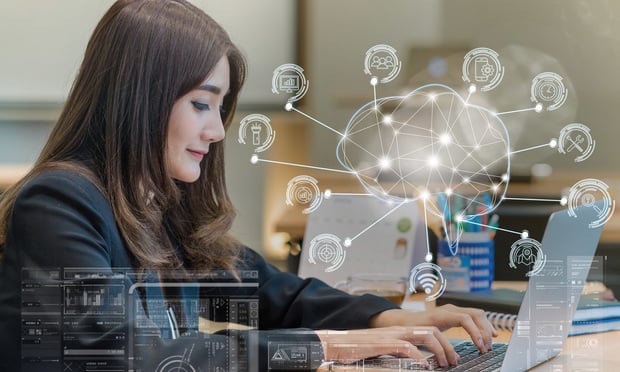Features

How to Implement Generative AI at Your Organization
AI language models are trained on massive amounts of data to function and improve. The more data the model is trained on, the better it gets at detecting patterns, anticipating what comes next, and producing realistic text. Right now, however, there are few controls in place to stop these models from scraping personal and private information from people and business.
Features

Will Section 230 Protect AI Chatbots?
The lack of answers from the Supreme Court regarding the scope of Section 230 of the 1996 Communications Decency Act comes at a time when legal questions around generative AI are mushrooming.
Features

Generative AI and Patent Considerations
A patent strategy informed by the unique considerations raised by generative AI will optimize protections for innovations in the field. Patent strategies should reflect the current legal landscape as well as anticipate potential future legal developments.
Features

Navigating the Risks and Opportunities of ChatGPT
The Implications of Data Breaches and Generative AI Platforms for the Legal Industry The pros and cons that law firms should consider before incorporating generative AI.
Features

ChatGPT & Generative AI: Everything You Need to Know, Part 2
Part Two of a Two-Part Article Part One of this article briefly detailed what "generative AI" tools like ChatGPT are and provided an overview of key legal considerations, including by looking forward to upcoming AI-specific legislation in the EU and the U.S. Part Two looks at AI-specific laws and the path forward for firms wanting to use AI in practice.
Features

Securing License for Internet Artificial Intelligence
The licensing of internet AI intellectual property is stymied because legal difficulties such as the proper assessment of the jurisdiction for the licensing agreement and the proper identification of the parties for the licensing agreement. However, the primary issue is that normally the licensor is a computer program, hence not a legal person.
Features

ChatGPT, Generative AI and IP Considerations
Part Two of a Two-Part Article Part One of this article briefly detailed what "generative AI" tools like ChatGPT are and provided an overview of key legal considerations. Part Two looks at upcoming AI-specific legislation and the path forward for firms wanting to use AI in practice.
Features

Licensing AI Content
The primary issue associated with securing a licensor's consent for Internet AI intellectual property is that normally the licensor is a computer program, hence not a legal person.
Features

Copyright Office On AI-Works Registrations
The U.S. Copyright Office recently found itself waffling on a copyright registration it granted, and then revoked, within a span of months. The work in question, a comic book, transcended the traditional artificial-intelligence authorship debate it contained an amalgam of human-created text and generative AI-created artwork.
Features

AI Isn't New to Law: How the Practice of Law Should Embrace AI
Understanding what AI is — and what it is not — helps to identify where it can be of value and what limitations it currently has. Not only will AI certainly impact your practice in the future, it already has.
Need Help?
- Prefer an IP authenticated environment? Request a transition or call 800-756-8993.
- Need other assistance? email Customer Service or call 1-877-256-2472.
MOST POPULAR STORIES
- The 'Sophisticated Insured' DefenseA majority of courts consider the <i>contra proferentem</i> doctrine to be a pillar of insurance law. The doctrine requires ambiguous terms in an insurance policy to be construed against the insurer and in favor of coverage for the insured. A prominent rationale behind the doctrine is that insurance policies are usually standard-form contracts drafted entirely by insurers.Read More ›
- A Lawyer's System for Active ReadingActive reading comprises many daily tasks lawyers engage in, including highlighting, annotating, note taking, comparing and searching texts. It demands more than flipping or turning pages.Read More ›
- The Brave New World of Cybersecurity Due Diligence in Mergers and Acquisitions: Pitfalls and OpportunitiesLike poorly-behaved school children, new technologies and intellectual property (IP) are increasingly disrupting the M&A establishment. Cybersecurity has become the latest disruptive newcomer to the M&A party.Read More ›
- Abandoned and Unused Cables: A Hidden Liability Under the 2002 National Electric CodeIn an effort to minimize the release of toxic gasses from cables in the event of fire, the 2002 version of the National Electric Code ("NEC"), promulgated by the National Fire Protection Association, sets forth new guidelines requiring that abandoned cables must be removed from buildings unless they are located in metal raceways or tagged "For Future Use." While the NEC is not, in itself, binding law, most jurisdictions in the United States adopt the NEC by reference in their state or local building and fire codes. Thus, noncompliance with the recent NEC guidelines will likely mean that a building is in violation of a building or fire code. If so, the building owner may also be in breach of agreements with tenants and lenders and may be jeopardizing its fire insurance coverage. Even in jurisdictions where the 2002 NEC has not been adopted, it may be argued that the guidelines represent the standard of reasonable care and could result in tort liability for the landlord if toxic gasses from abandoned cables are emitted in a fire. With these potential liabilities in mind, this article discusses: 1) how to address the abandoned wires and cables currently located within the risers, ceilings and other areas of properties, and 2) additional considerations in the placement and removal of telecommunications cables going forward.Read More ›
- Guidance on Distributions As 'Disbursements' and U.S. Trustee FeesIn a recent case from the Bankruptcy Court for the District of Delaware, In re Paragon Offshore PLC, the bankruptcy court provided guidance on whether a post-plan effective date litigation trust's distributions constituted disbursements subject to the U.S. Trustee fee "tax."Read More ›
